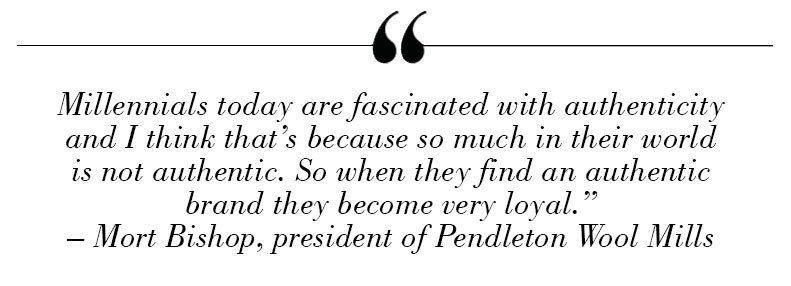LET’S GET DOMESTIC

For a while, American-made menswear lost its mojo. As large textile mills and factories emerged in developing countries like China, their American counterparts couldn’t compete. Domestic mills and factories folded, and with them, so did their histories, heritage, and craftsmanship. By the early 1980s, big retail chains like Gap Inc. and JCPenney had transitioned much of their manufacturing overseas.
With the notable exception of Prep, the stylish set turned their attentions to Europe. “In the ’50s and ’60s, we were at an apex of American style and design, but through the ’70s and ’80s, the Italians really took over,” laments Jacob Long, CEO of American Woolens. “Go back to the Italian advertisements of the 1970s: they were about conjuring up this idea of sophistication; we were conjuring up this imagery of convenience. The apparel companies did a lot of disservice by not focusing on what American style was about.”
As the years progressed, it didn’t help that international trade agreements continued to draw manufacturers away from the U.S. “With the North American Trade Agreement in 1994, we opened up a new facility in Mexico and rerouted all our apparel business there,” says Pete Baumann, senior vice president at Burlington Industries. “It’s only been recently that we decided to reinvigorate our tailored clothing business with products manufactured in our Raeford, North Carolina facility.”
Ironically, the revival of the American garment industry was sparked by the 2008 recession. After that economic downturn, heritage brands like Woolrich, Filson and Pendleton began to find favor with a generation whose patriotism was fueled in part by austerity. “We saw the American male revert back to a simpler, more comfort-oriented American value-based taste level,” explains Mort Bishop, president of Pendleton Woolen Mills. “Brands that he was familiar with, through his father or his grandfather, created a resurgence in interest in Pendleton. Millennials today are fascinated with authenticity and I think that’s because so much in their world is not authentic. So when they find an authentic brand they become very loyal.”
“Authenticity has become very important to the Millennial consumer,” agrees Kara Nicholas, VP of design and marketing at Cone Denim. “We have these beautiful historical looms, and the selvedge denim they produce has become recognized and celebrated on a global scale.”
What exactly makes something “authentic” is debatable, but there is something undeniably inauthentic about a “Made in China” label sewn in a sweater by an American company. “We think there’s big value in Made in the USA,” says Baumann. “We want to hit the high end of our business, to sell to people like Polo, Hickey Freeman, Brooks Brothers, Southwick, and to customers who would normally buy Italian goods. We’re concentrating on 110s and mostly 120s to appeal to a better tailored market than our replenishment product in Mexico does.”
Right now, the premium business is where Made in America can best compete. “If you want to go after low retail cost/commodity products, you’re going to go offshore because the inputs are so inexpensive,” says W Diamond Group CEO Douglas Williams. “But when you’re talking about high-quality garments, the U.S. has a competitive advantage with programs like the Tariff Rate Quota license and the Wool Trust program. You’re able to bring fabrics into the United States fundamentally duty free, you’re not paying duty on labor, plus speed to market is 30 to 40 days faster.”
Another competitive advantage is quality control. “When you’re selling a high-quality, specialized garment it’s ideal to be close to the factory and the wash houses to make sure everything is done correctly,” explains Jeff Shafer, founder of Agave Denim. “That doesn’t mean that other countries couldn’t do a good job, but having 24/7 access to the sewing and design houses and laundries in Los Angeles and Woodstock is a huge strategic asset.” There are also ethical and integrity issues to consider. “Many factories in developing countries don’t have strict rules on things like minimum age, overtime, health care, and working conditions,” points out Shafer. David Hart, who manufactures in New York, makes a similar point. “I make in New York because of the relationships I can have with my factories. It’s great to have a personal relationship with the workers and know that they are being treated well.”
Despite all this industry movement, the real barometer of the success of Made in America will be the customer. And the jury is still out on that, say retailers. “Everyone loves the idea of Made in America,” says Macy’s VP, fashion director Durand Guion. “But I still find that mass customers aren’t willing to take on the extra price point. As more manufacturing returns to the U.S. and we learn how to be competitive in a new retail landscape that is more price-sensitive than ever, then I think it will be a great story.”
“As a retailer and as a New York-based brand, of course we want to support manufacture in our backyard, so it’s absolutely on my radar. I’m looking at it very closely,” says Eric Jennings, VP, fashion director at Saks Fifth Avenue.
“The honest truth is that right now when I go in to see a new collection, for better or for worse, I can tell if it’s made in New York. It has a certain hand, a stitch; I can always tell. Is it the best out there? Not always, so there’s work to be done. But at a recent in-store event for some of our emerging young designers, as I was presenting Timo Weiland I mentioned that the clothes were made in New York and the audience applauded, so I know the appreciation is there.”
Fortunately, this piquing of consumer interest has given rise to new programs by the CFDA, the AAFA, and Manufacture NY to aid the cause. “Manufacturers, especially those in the garment district, are faced with their rents tripling, or even just being kicked out entirely,” explains Manufacture NY founder and CEO Bob Bland. “In 2012, Made in America was just coming up as something of interest to the fashion industry. Up until that time no one had seen the value of bringing products back home because the prices overseas are so much cheaper,” she says. “Initially, we started a Garment Center pilot program: a 
After all, more than just American pride is at stake. “The fashion industry accounts for 5.5 percent of the city’s workforce and generates billions of dollars in tax revenue annually,” says Christopher Carrolls, public affairs associate at the NYC Economic Development Corporation. “The city is committed to supporting this legacy industry by creating programs that are designed to assist local manufacturers and designers in addressing the challenges that are associated with growing businesses in the City, from helping develop marketing strategies and business plans to helping finance the acquisition of equipment or training a workforce.”
These initiatives, coupled with an increased awareness of the benefits of domestic production from both logistical and broader economic perspectives, are definitely spurring the industry’s growth. “Apparel and footwear contributed a record $361 billion to the U.S. economy last year, a bigger contribution than new cars, alcohol, toys, or practically any other industry,” explains AFAA president and CEO Juanita Duggan. “The rebound in Made in America clothes and shoes, first seen in 2011, has risen 6.2 percent and 8.5 percent respectively.”
That increase is substantial, and projections for this year look even better than the last. It looks like those that have put down roots at home are well positioned for the future.












